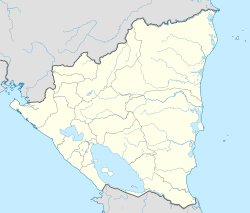Muelle de los Bueyes facts for kids
Quick facts for kids
Muelle de los Bueyes
Bullocks Wharf (Creole)
|
|
|---|---|
|
Municipality
|
|
| Country | |
| Department | South Caribbean Coast Autonomous Region |
| Area | |
| • Municipality | 530 sq mi (1,380 km2) |
| Population
(2022 estimate)
|
|
| • Municipality | 24,552 |
| • Density | 46.08/sq mi (17.79/km2) |
| • Urban | 11,123 |
| Climate | Am |
Muelle de los Bueyes is a town and a special area in Nicaragua. It is part of the South Caribbean Coast Autonomous Region. This region is like a large county with its own local government.
Contents
Where is Muelle de los Bueyes?
Muelle de los Bueyes is surrounded by other towns and areas. To the north and east, it borders El Rama. To the south, you will find El Coral and Nueva Guinea. To the west are Villa Sandino and Santo Tomás.
The main town of Muelle de los Bueyes is about 250 kilometers (about 155 miles) away from Managua, which is the capital city of Nicaragua.
A Look at History
How the Town Started
For a long time, until the early 1900s, the area where Muelle de los Bueyes is now was a thick, empty jungle. It divided Nicaragua into two parts.
In the 1930s, American companies needed rubber and a similar material called hule. This need brought the area into the economy of Nicaragua's Caribbean coast. The jungle became a place to get these products.
The Ox Cart Connection
The rubber and hule were moved using the Mico-Escondido River route to a city called Bluefields. The main town of Muelle de los Bueyes, which was then called San Pablo, became a key transfer spot. Workers would move the goods from ox carts onto river boats right here.
Because so many oxen (male cattle) were gathered in this area, the place got its current name, "Muelle de los Bueyes." This means "Oxen's Wharf" or "Bullocks' Dock." The need for workers to handle these goods helped the town grow.
Becoming a Municipality
Muelle de los Bueyes officially became its own municipality in 1942. This happened after it separated from the larger area of El Rama.
Growth and Agriculture
Another big wave of people moved to the area from the 1950s until after 1974. This was because Nicaragua was becoming more involved in the global market. The country started producing a lot of cotton and meat to sell to other countries. This created more jobs and opportunities in places like Muelle de los Bueyes.
People of Muelle de los Bueyes
Muelle de los Bueyes has a population of 24,552 people. The number of men and women is almost equal. About 49.6% of the people are men, and 50.4% are women.
Where People Live
Most people in Muelle de los Bueyes live in rural areas. About 54.7% of the population lives in the countryside. The remaining 45.3% live in the urban areas, which are the towns and cities.
Nature and Weather
Muelle de los Bueyes has a tropical climate. This means it is warm and wet most of the time. The area has very moist forests.
Temperatures and Rain
The average temperature throughout the year is about 26°C (79°F).
- From December to February, it gets a bit cooler. Temperatures range from 17°C to 25°C (63°F to 77°F). This is because of cold air coming from the north.
- From March to August, it gets warmer, with temperatures reaching up to 33°C (91°F).
It rains a lot in Muelle de los Bueyes, usually for about nine months of the year. The total rainfall each year is between 2700 and 2900 millimeters (about 106 to 114 inches).
Towns and Villages
Muelle de los Bueyes has 8 main populated centers. It also has about 54 smaller communities called "comarcas."
Main Populated Centers
The main towns and villages include:
- Muelle de los Bueyes (this is the main town and the center of the municipality)
- Presillas (the second largest town after Muelle de los Bueyes)
- Cara de Mono
- El Cacao
- La Batea
- El Espavel
- La Gorra
- Campana
Economy and Jobs
Muelle de los Bueyes has excellent land and water resources. This makes livestock farming the most important economic activity. People also do a lot of agriculture, which means growing crops.
Local Businesses
One of the most well-known businesses in the livestock sector is a dairy company called Castilac. It is often known as El Guanaco and is owned by the Miranda family. They process milk and make dairy products.
See also
 In Spanish: Muelle de los Bueyes para niños
In Spanish: Muelle de los Bueyes para niños


